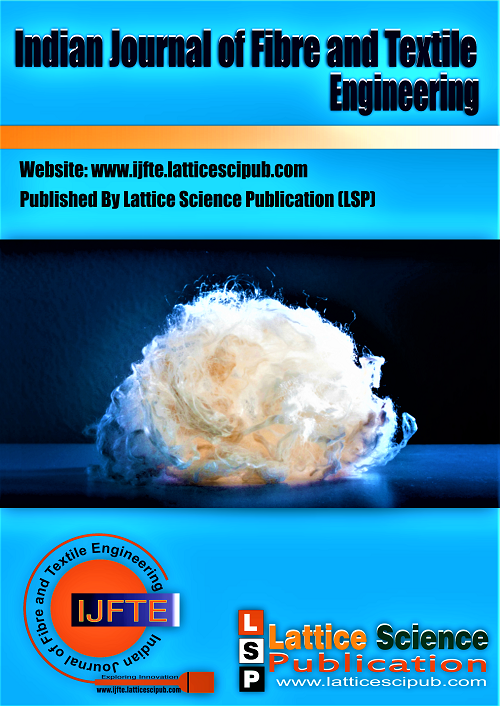Protecting Hand-Knotted Carpets with Microbial Resistance
Main Article Content
Abstract
The carpet is a textile material known for its aesthetic appeal and is widely used for enhancing home and workplace décor. The hand-knotted carpets made from natural fibres like cotton tend to allow microbial growth when exposed to hot and humid conditions. This study involves the application of anti-microbial finishing chemicals developed from natural oils like Neem, Basil, and Aloe vera. Nano-emulsion of essential oil was prepared with polyoxyethylene sorbitan monooleate as a surfactant using a high-speed Homogenizer at 15K rpm for 30 minutes. These essential oils can repel insects like house flies and prevent the growth of microbes which cause human health-related issues like skin itching, irritation, sneezing and allergy. Varying concentrations of emulsion oil 1% and 5% were used to prepare nano-emulsion formulation, and the particle size and thermal stability were evaluated. FTIR analysis of the emulsion was done to check the presence of functional groups. The spraying technique was used for the application of neem oil emulsion on the carpet and dried. The finished carpet was tested for the anti-microbial performance effect and found to provide adequate microbial protection.
Downloads
Article Details

This work is licensed under a Creative Commons Attribution-NonCommercial-NoDerivatives 4.0 International License.
How to Cite
References
Giri, A. K., Singh, S. P. (2022). India's hand-knotted carpet industry in reforms era: export performances and challenges. International Journal of Business and Globalisation, 31(1), 17-35. https://doi.org/10.1504/IJBG.2022.124521
Malik, M. R., Prasad, R. (2015). Indian carpet industry after trade liberalization. Problems and prospects. Academic Journal of Economic Studies, 1(3), 79-87.
Bano, M. R. (2015). Growth Performance and Global Perspective of Indian Hand Knotted Carpet. Asia Pacific Journal of Research Vol: I. Issue XXIV.
Pandey, S. K. (2015). Emerging Opportunities and Challenges in Indian Carpet Industry. Asian Journal of Multidisciplinary Studies, 3(1), 21.
Purwar, R., Joshi, M. (2004). Recent Developments in Antimicrobial Finishing of Textiles--A Review. AATCC review, 4(3).
Afraz, N., Uddin, F., Syed, U., Mahmood, A. (2019). Antimicrobial finishes for textiles. Current Trends in Fashion Technology & Textile Engineering, 4(5), 87-94. https://doi.org/10.19080/CTFTTE.2019.04.555646
Simoncic, B., Tomsic, B. (2010). Structures of novel antimicrobial agents for textiles- a review. Textile Research Journal, 80(16), 1721-1737.8 https://doi.org/10.1177/0040517510363193
Cheng, X., Ma, K., Li, R., Ren, X., Huang, T. S. (2014). Antimicrobial coating of modified chitosan onto cotton fabrics. Applied Surface Science, 309, 138-143. https://doi.org/10.1016/j.apsusc.2014.04.206
Balamurugan, G. K., Babuskin, S. (2018). Antimicrobial coating of cotton twill tape with neem oil, eucalyptus oil and tulsi oil for medicinal application. Current Science, 115(4), 779-782. https://doi.org/10.18520/cs/v115/i4/779-782
Chauhan, M., Mani, P., Sharma, T., (2018). The Antibacterial Activities of Neem [Azadirachta Indicia] Seed Oil, A Review, IOSR Journal of Applied Chemistry (IOSR-JAC), Volume 11, Issue 5, Pages: 58-63.
Cohen M. (2014), Tulsi : A herb for all reasons, Journal of Ayurveda and integrative medicine, Volume 5, Issue 4, Pages 251-259. https://doi.org/10.4103/0975-9476.146554
El-Khatib, E. M., Ali, N. F., El-Mohamedy, R. S. (2020). Influence of Neem oil pretreatment on the dyeing and antimicrobial properties of wool and silk fibers with some natural dyes. Arabian Journal of chemistry, 13(1), 1094-1104. https://doi.org/10.1016/j.arabjc.2017.09.012
Prieto, C., Calvo, L. (2013). Performance of the biocompatible surfactant Tween 80, for the formation of microemulsions suitable for new pharmaceutical processing. Journal of Applied Chemistry. https://doi.org/10.1155/2013/930356
B. K. Das*, “Determinants of Exports in India,” International Journal of Innovative Technology and Exploring Engineering, vol. 2, no. 9. Blue Eyes Intelligence Engineering and Sciences Engineering and Sciences Publication - BEIESP, pp. 1208–1213, Dec. 30, 2019. doi: 10.35940/ijitee.b7840.129219. Available: http://dx.doi.org/10.35940/ijitee.B7840.129219
P. B. Ibarra, “Development of Trade Relations Between Mexico and China Under Non-Bilateral Trade Treaties,” International Journal of Management and Humanities, vol. 4, no. 10. Blue Eyes Intelligence Engineering and Sciences Engineering and Sciences Publication - BEIESP, pp. 190–223, Jun. 15, 2020. doi: 10.35940/ijmh.j0958.0641020. Available: http://dx.doi.org/10.35940/ijmh.J0958.0641020
S. Das et al., “Deep Learning Convolutional Neural Network for Defect Identification and Classification in Woven Fabric,” Indian Journal of Artificial Intelligence and Neural Networking, vol. 1, no. 2. Lattice Science Publication (LSP), pp. 9–13, Apr. 10, 2021. doi: 10.54105/ijainn.b1011.041221. Available: http://dx.doi.org/10.54105/ijainn.B1011.041221
S. J. Kabilan, R. Baskar, and G. Poorani, “Herbal Tea Formulation for Health Rejenuvation: Nutritional, Physicochemical and Sensory Analysis,” International Journal of Engineering and Advanced Technology, vol. 9, no. 1s4. Blue Eyes Intelligence Engineering and Sciences Engineering and Sciences Publication - BEIESP, pp. 783–788, Dec. 30, 2019. doi: 10.35940/ijeat.a1144.1291s419. Available: http://dx.doi.org/10.35940/ijeat.A1144.1291S419
V. Pimple* et al., “Plant Essential Oils Based Nanoemulsion Formulations and Its Antibacterial Effect on Some Pathogens,” International Journal of Innovative Technology and Exploring Engineering, vol. 9, no. 1. Blue Eyes Intelligence Engineering and Sciences Engineering and Sciences Publication - BEIESP, pp. 4800–4808, Nov. 30, 2019. doi: 10.35940/ijitee.a6112.119119. Available: http://dx.doi.org/10.35940/ijitee.A6112.119119





